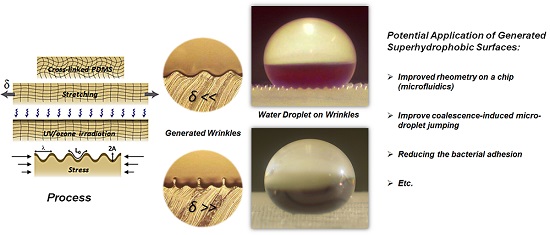
Lotus flowers, rose petals, some plant leaves and insects have a naturally super-hydrophobic surface. In fact, the surface of a Lotus leaf is covered by micro and nano structures mixed with wax, which makes its surface superhydrophobic. In microfluidics, superhydrophobicity is an important factor in the rheometers on a chip. It is also sought in other complex fluids applications like the self-cleaning and the antibacterial materials. The wettability of the surface of solid support can be modified by altering its chemical composition. This means functionalizing the interface molecules to different chemical properties, and/or forming a thin film on the surface. We can also influence its texturing by changing its roughness. Despite considerable efforts during the last decade, superhydrophobic surfaces usually involve, among others, microfabrication processes, such as photolithography technique. In this study, we propose an original and simple method to create superhydrophobic surfaces by controlling elastic instability of poly-dimethylsiloxane (PDMS) films. Indeed, we demonstrate that the self-organization of wrinkles on top of non-wettable polymer surfaces leads to surperhydrophobic surfaces with contact angles exceeding 150°. We studied the transition Wenzel-Cassie, which indicated that the passage of morphology drops "impaled" to a type of morphology "fakir" were the strongest topographies.
from #Medicine via ola Kala on Inoreader http://ift.tt/1rOworH
via
IFTTT
Δεν υπάρχουν σχόλια:
Δημοσίευση σχολίου
Σημείωση: Μόνο ένα μέλος αυτού του ιστολογίου μπορεί να αναρτήσει σχόλιο.